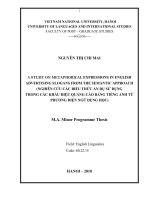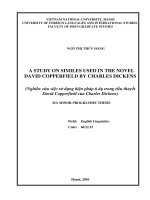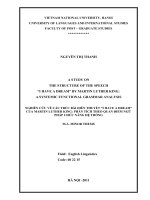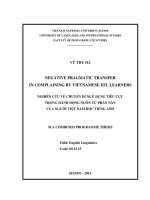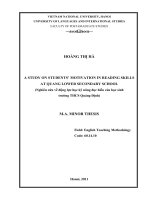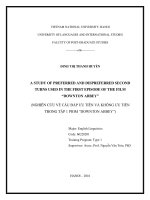a study of dispreferred second turns used in part a – listening section of toefl pbt = nghiên cứu về câu đáp không được ưu tiên trong phần a - nghe hiểu toefl
Bạn đang xem bản rút gọn của tài liệu. Xem và tải ngay bản đầy đủ của tài liệu tại đây (582.96 KB, 53 trang )
VIET NAM NATIONAL UNIVERSITY, HA NOI
UNIVERSITY OF LANGUAGES AND INTERNATIONAL STUDIES
Faculty OF Post-graduate STUDIES
o0o
NGUYEN THI OANH
A STUDY OF DISPREFERRED SECOND TURNS USED
IN PART A – LISTENING SECTION OF TOEFL PBT
(NGHIÊN CỨU VỀ CÂU ĐÁP KHÔNG ĐƯỢC ƯU TIÊN
TRONG PHẦN A – NGHE HIỂU TOEFL PBT)
Field: MA in English Linguistics
Code: 60.22.02.01
Training Program: Type 1
Hanoi – 2013
VIET NAM NATIONAL UNIVERSITY, HA NOI
UNIVERSITY OF LANGUAGES AND INTERNATIONAL STUDIES
Faculty OF Post-graduate STUDIES
o0o
NGUYỄN THỊ OANH
A STUDY OF DISPREFERRED SECOND TURNS USED
IN PART A – LISTENING SECTION OF TOEFL PBT
(NGHIÊN CỨU VỀ CÂU ĐÁP KHÔNG ĐƯỢC ƯU TIÊN
TRONG PHẦN A – NGHE HIỂU TOEFL PBT)
Field: English Linguistics
Code: 60.22.02.01
Training Program: Type 1
Supervisor: Dr. Kiều Thị Thu Hương
Hanoi – 2013
I
DECLARATION
I hereby, certify the thesis entitled “A study of Dispreferred Second
Turns used in part A – Listening Section of TOEFL PBT”is the result of my
own research for the Minor Degree of Master of Arts in English Linguistics at
University of Languages and International Studies, Vietnam National
University, Hanoi. The thesis has not been submitted for any degree at any other
universities or institutions.
I agree that the origin of my thesis deposited in the library can be
accessible for the purposes of study and research, in accordance with the
normal conditions established by the librarian for the care, loan and
reproduction of the paper.
Hanoi, October 1
st
, 2013
Signature
Nguyen Thi Oanh
II
ACKNOWLEDGEMENTS
First of all, I would like to express my special thanks to Dr. Kieu Thi Thu Huong, my
supervisor, for her exciting lectures on Pragmatics, her valuable advice and continual
supports without which I could not have finished my thesis.
I owe Assoc. Prof. Dr. Le Hung Tien my deep debt of gratitude for his useful and
interesting course in Research Methodology, which provides me with indispensable
techniques to complete this thesis.
My heartfelt thanks go to all the staff, teachers and members at Faculty of Post-
Graduate Studies - University of Languages and International Studies - Vietnam
National University, Hanoi for their work and services.
Especially, I would like to show my profound gratitude to all the librarians at Faculty
of Post-Graduate Studies during my searching for reference books. Their enthusiastic
cooperation is really precious towards the results of my study.
I would like to express my warmest thanks to my family for their support and
encouragement during the completion of this research.
Finally, I am also grateful to all the authors whose books, newspapers and magazines I
have referred to.
III
ABSTRACT
The main objective of this thesis is discovering the general patterns of dispreferred
second turns and the common linguistic features indicating them in part A – Listening
Comprehesion Section of TOEFL PBT based on the theoretical frameworks of
pragmatics and conversation analysis.
The corpus of the study consists of 50 dialogs containing dispreferreds in Part A. Both
quantitative and qualitative methods have been used to find out the answers to the
research questions.
There are some findings in the research. In the first place, the five patterns of
dispreferreds, namely assessment-disagreement, invitation-refusal, proposal-
disagreement, offer-declination and request-refusal, are all used in Part A and the
pattern assessment-disagreement is the most common one. Also, there are eight
common linguistic elements indicating dispreferreds among which ‗give an account‟
ranks the most. The data analysis also points out that each linguistic feature is priorly
used in one or some certain patterns of dispreferreds.
IV
TABLE OF CONTENTS
DECLARATION I
ACKNOWLEDGEMENTS II
ABSTRACT III
TABLE OF CONTENTS IV
LISTS OF TABLES & FIGURES VI
ABBREVIATIONS & CONVENTIONS VII
PART I - INTRODUCTION 1
1. Statement of the Problem 1
2. Research Question 2
3. Objectives of the study 2
4. Significance of the study 3
5. Scope of the study 3
6. Design of the study 4
PART II - DEVELOPMENT 5
CHAPTER I: LITERATURE REVIEW 5
1.1. Speech Acts 5
1.1.1. Definition 5
1.1.2. Common kinds 5
1.2. Conversation Analysis 6
1.2.1. Definition 6
1.2.2. Turn-taking 7
1.2.3. Adjacency pairs 7
1.3. Preference structure 9
1.3.1. Definition 9
1.3.2. General patterns of preference structure 10
1.3.3. Dispreferred second turns 11
1.4. Dispreferreds in Part A - Listening Comprehension of TOEFL PBT 14
1.5. Previous works 17
CHAPTER II: THE STUDY 19
2.1. Database 19
V
2.2. Methodology 19
2.3. Procedure 20
2.4 Findings and discussion 21
2.4.1. General patterns of dispreferreds 21
2.4.2. Common linguistic features of dispreferreds 22
PART III - CONCLUSION 34
1. Recapitulation 34
1.1. The common patterns of dispreferreds 34
1.2. The linguistic features signaling dispreferreds 34
2. Suggested tips for TOEFL PBT learners or potential test-takers 36
3. Implications for English language learning and test taking 37
4. Limitations of the research 39
5. Suggestions for further research…….…………………………………………40
REFERENCES
VI
LISTS OF TABLES & FIGURES
CONTENTS
Table 1 - Correlations of content and format in adjacency pair seconds
Table 2 - The general patterns of preferred and dispreferred structures
Table 3 - Linguistic elements indicating dispreferred second turns
Table 4 - Listening Comprehension Format in Standard Form
Figure 1 - Common patterns of dispreferred second turns
Figure 2 - Linguistic features indicating dispreferreds
PAGE
10
11
12
14
21
22
VII
ABBREVIATIONS & CONVENTIONS
ETS Educational Testing Service
ASEAN The Association of South East Asian Nations
AFTA ASEAN Free Trade Area
APEC Asia-Pacific Economic Cooperation
ASEM Asia-Europe Meeting
WTO World Trade Organization
TOEFL Test of English as a Foreign Language
TOEFL PBT Test of English as a Foreign Language Paper-Based Test
TOEFL CBT Test of English as a Foreign Language Computer-Based test
TOEFL IBT Test of English as a Foreign Language Internet-Based Test
IELTS International English Language Testing System
TOEIC Test of English for International Communication
M Male
F Female
F1 Female 1
F2 Female 2
M1 Male 1
M2 Male 2
CA Conversation Analysis
SA Speech Act
// Point at which the current utterance is overlapped by that
transcribed below
Q1 Question 1
& And
VIII
(( )) ―some phenomenon that the transcriber does not want to
wrestle with‖ or some non-vocal action, etc.
hh an audible out-breath, .hh an in-breath
S Speaker
H Hearer
1
PART I
INTRODUCTION
1. Statement of the Problem
Since 1986, after having launched its open-door policy ―Doi Moi‖, Vietnam has gone
through remarkable changes to be a market economy and set up relations with more
than 200 countries and regions in the world. It also became a member of many
important organizations such as ASEAN, AFTA, APEC, ASEM, WTO and so on. In
this converging trend, Vietnam is becoming more and more involved in international
trade and investment.
To keep track of this globalization trend, the Vietnamese government has encouraged
its citizens to learn English. As a result, English has become the most popular foreign
language studied in schools and colleges. Also, some international certificates like
TOEIC, TOEFL and IELTS have gradually become a requirement for college
graduates and employees who need to achieve academic success as well as effective
communication.
As a matter of fact, learners of English often find these tests quite challenging,
especially the listening part as mentioned by Brown (2006:1), ―Listening in another
language is a hard job‖. To take TOEFL PBT Listening Part as an example, its
materials often include dialogs, academic lectures and long conversations that require
test-takers to have to infer the speakers‘ implicit ideas, attitudes or purposes. Thus,
besides the language competence, test-takers need pragmatic knowledge to do the
tests.
However, up to now, few studies on the barriers TOEFL PBT test-takers have
encountered have been carried out. Therefore, this study is conducted to investigate a
small aspect of pragmatics and conversation analysis - common patterns of
2
dispreferred second turns and linguistic units to signal them in Part A - Listening
Comprehension Section of TOEFL PBT tests in order to work out some tips that help
test-takers to cope with these kinds of questions.
In short, the crucial role of TOEFL tests, the difficulties facing TOEFL test-takers, the
lack of attention of the previous papers and self-interest in Pragmatics are the
motivation for the author to conduct the study on ―Dispreferred second turns used in
Part A – Listening Section of TOEFL PBT”.
2. Research Question
The research seeks the answer to the following question:
What are the general patterns of dispreferred structures and the common linguistic
features indicating them in Part A - Listening Comprehension Section of TOEFL
PBT?
3. Objectives of the study
More obviously, to solve the research question, the study is conducted to:
Provide readers with basic knowledge of speech acts, conversation analysis,
adjacency pairs and preference structure.
Find out the general patterns of dispreferred structures used in Part A -
Listening Section of TOEFL PBT.
Examine the linguistic features signaling dispreferred responses in Part A -
Listening Comprehension of TOEFL PBT.
Provide potential test-takers with practical knowledge to deal with TOEFL PBT
questions containing dispreferred-second-turn questions.
3
4. Significance of the study
First and foremost, this paper can be used as a useful reference source for teachers as
well as learners who have been teaching and studying TOEFL PBT. It enables them to
understand conversation analysis, adjacency pairs, preference structure, dispreferreds,
their general patterns and the linguistic units signaling them more deeply. Good
understanding and full consciousness can help them deal with listening questions in
Part A - TOEFL PBT more easily. At the same time, deep knowledge can let them
communicate in English in a more natural and effective way, particularly when giving
an indirect decline, refusal or disagreement.
Secondly, teachers and learners of TOEFL PBT can use the paper as a handbook to
seek some tips to cope with questions that contain dispreferred-second-turn responses
in Listening Comprehension Section.
Last but not least, researchers of related fields can also use the paper for reference and
suggestions for deeper studies.
5. Scope of the study
Due to time constraints and within the framework of a minor thesis submitted in partial
fulfillment of the requirements for the Degree of Master of Arts in English Linguistics,
the present study only investigates the small aspects of preference structure: the
common patterns of dispreferred-second acts and the frequently used linguistic
features to indicate them in Part A - TOEFL PBT Listening Section.
The research focuses on the analysis of the transcripts of 50 out of 300 dialogs that
contain the utterances of dispreferreds in Part A - Listening Comprehension taken
from 10 Complete Practice Tests of three books including TOEFL Success 2000 by
Bruce Rogers, The Heinle & Heinle TOEFL Test Assistant Listening by Milada
Broukal and TOEFL Practice Tests Volume 3 by ETS.
4
6. Design of the study
The study includes three parts:
Part I is the Introduction of the study which states the problem, the research
question, objectives, scope, significance and design of the entire paper.
Part II is the Development which consists of two chapters. Chapter 1 presents the
theoretical background related to the topic. Chapter 2 includes database of the
study, methodology, data analysis procedure, and discussion of data analysis.
Part III is the Conclusion which summarizes major findings of the investigation
and provides implications for teaching and learning TOEFL PBT. This part also
points out some limitations of the research & makes suggestions for further studies.
5
PART II
DEVELOPMENT
CHAPTER I: LITERATURE REVIEW
1.1. Speech Acts
1.1.1. Definition
It goes a broad consensus that of all the issues in the general theory of language usage,
the speech act (SA) theory has probably aroused the widest interest. After Austin‘s
initial investigation into SAs a few decades ago, the notion of SAs has become one of
the most exciting notions to take a close look at.
In linguistic pragmatics, SAs have remained the central phenomena that every general
pragmatic theorist must take into account. That is the reason why there have been a
great number of works on SAs carried out by many philosophers and linguists such as
Grice (1957, 1975), Searle (1969), Levinson (1983), Thomas (1995) and Yule (1996).
Most of these linguists and philosophers share the common idea that when producing
utterances, interlocutors also perform actions, i.e. ―in saying something the speaker (S)
does something‖ (Austin, 1962).
Briefly speaking, ―actions performed via utterances‖ are called speech acts (Yule,
1996: 47). According to Searle (1969: 16), these SAs, considered ‗the basic or minimal
units of linguistic communication, are performed in authentic situations of language
use.
1.1.2. Common kinds
In English, SAs are commonly given specific labels such as greeting, assessment,
offer, agreement, disagreement, compliment, apology, complaint, invitation, request,
refusal, blame, acceptance, denial, admission, question, answer, proposal or promise.
6
These terms for SAs are used to name the S's communicative intentions and the hearer
(H) is expected to correctly interpret the S's intentions via the process of inferences.
For example,
“Hi, Mary. How are things going?"
greeting
"Could you lend me your pen, please?"
request
1.2. Conversation Analysis
1.2.1. Definition
The term ―conversation‖ may be taken to be the familiar predominant ―type of talk in
which two or more participants freely alternate in speaking, which generally occurs
outside specific institutional settings like religious services, law courts, classrooms and
the like‖ (Levinson , 1983: 284). In other words, conversation can be understood as
talks produced in ordinary human interactions. Levinson does not see conversation as
a structural product as the sentence but the outcome of the interaction of two or more
independent, goal-directed individuals, with often divergent interests.
The approach used to analyze conversations is called conversation analysis (CA)
which, at its core, in Sidnell‘s words (2010), is a set of methods for working with
audio and video recordings of talk and social interaction. It is regarded as a social-
science approach that has the primary purpose of describing, analyzing and
understanding talk as a basic and constitutive feature of human social life.
Also discussing CA, Hutchby & Wooffitt (2008) calls it ‗the study of recorded,
naturally occurring talk-in-interaction‘ that aims to discover how speakers understand
and respond to one another in their turns at talk. CA serves as a central focus on how
sets of action are generated. In other words, the aim of CA is to uncover the often tacit
reasoning procedures and sociolinguistic competencies underlying the production and
interpretation of talk in organized sequences of interaction.
7
The purpose of CA, according to Levinson (1983: 287), is to discover the systematic
properties of the sequential organization of talk, and the ways in which utterances are
designed to manage such sequences. CA has to satisfy two requirements. First, its
methods need to be inductive - search is made for recurring patterns across many
records of naturally occurring conversations. Second, the emphasis should be put on
the interactional and inferential consequences of the choice between alternative
utterances.
When it comes to the analytic studies on English data, local management organizations
in conversation, namely turn-taking and adjacency pairs, cannot be omitted.
1.2.2. Turn-taking
According to Levinson (1983: 296), it can be easily seen that conversation is
characterized by turn-taking: one participant, A, talks, stops; another, B, starts, talks,
stops; and we obtain A-B-A-B-A-B distribution of talk across two participants.
To share this opinion, Yule (1996: 71) also states that the structure of conversation is
based on ―analogy with the workings of a market economy‖ in which there is a scarce
commodity - the floor or the right to speak. Having control of this right at any time,
the speaker gets a turn. In any situation, where control is not fixed in advance, anyone
can attempt to get control, we have turn-taking.
1.2.3. Adjacency pairs
Let us now turn to another local management organization in conversation - adjacency
pairs - that is one of the most significant contributions of CA.
Adjacency pairs are defined by Levinson (1983: 303) as the kind of paired
utterances of which question-answer, greeting-greeting, offer-acceptance, apology-
minimization, etc., are prototypical.
Yule (1996: 77) calls adjacency pairs ―automatic patterns/sequences in the structure
of conversations‖ that always ―consist of a first part and a second part produced by
8
different speakers‖. Adjacency pairs, according to Yule, can be greeting-greeting,
question-answer, thank-response, request-acceptance, etc. For example,
Anna: Hello.
Bill: Hi.
Anna: How are you?
Bill: Fine!
Anna: See ya!
Bill: Bye!
Thornbury & Slade (2006) show that an adjacency pair consists of two turns made by
different speakers which are placed adjacently and where the second utterance is
identified as related to the first. An adjacency pair can be include question-answer;
complaint-denial; offer-accept; request-grant; compliment-rejection; challenge-
rejection, and instruct-receipt. According to Thornbury & Slade (2006), adjacency pairs
typically have three characteristics: they consist of two utterances; the utterances are
adjacent, i.e. the first immediately follows the second; and different speakers produce
each utterance.
In addition, adjacency pairs, in Yule‘s perspective, are not simply contentless noises in
sequence. They represent social actions, and not all of social actions are equal when
they occur as second turns of some pairs.
Levinson (1983: 306-07) states that there is a problem that arises with the notion of an
adjacency pair concerns the range of potential seconds to a first part. The problem here
is that a first part may, in fact, receive a great many acceptable responses rather than the
fixed one in its pair. For instance, a question can have some proper responses other than
an answer such as protestations of ignorance, re-routes, refusals to provide an answer,
and challenges to the presuppositions or sincerity of the question:
A: What does John do for a living?
B: a. Oh that and this.
b. He doesn‟t.
9
c. I have no idea.
d. What‟s that got to do with it?
(Levinson, 1983: 293)
We have another case in which the response to a question is not an answer but a
promise to provide an answer at a later date, together with an account that explains the
deferral:
A: Yes // how many tubes would you like sir? ((Q1))
B: Er, hh I‟ll tell you what I‟ll just eh eh ring you back I have to work
out how many I‟ll need. Sorry I did- wasn‟t sure of the price you see.
(Levinson, 1983: 305)
Therefore, although the response to a first part may be limited, they certainly do not
form a small set. This does seem to undermine the structural significance of the idea of
adjacency pair that is revived by the concept of preference organization/ structure.
1.3. Preference structure
1.3.1. Definition
Yule (1996: 78) mentions that basically, a first part that contains a request or an offer
is typically made in the expectation that the second part will be an acceptance. An
acceptance is structurally more likely than a refusal. This structural likelihood is called
preference. Preference is the term used to indicate a socially determined structural
pattern and does not refer to any individual‘s mental or emotional desires. Sharing this
attitude, Levinson (1983: 332-333) claims that the notion of preference is not intended
as a psychological claim about speaker‘s or hearer‘s desires, but as a label for a
structural phenomenon very close to the linguistic concept of ―markedness”. In brief,
preference is not a personal wish but an observed pattern in talk.
10
Preference structure divides second turns into two categories, i.e. preferred and
dispreferred social acts. The preferred is the structurally expected next act and the
dispreferred one is the structurally unexpected act.
According to Comrie (1976a: 114), ―unmarked categories tend to have less
morphological material than marked categories‖ and there is ―greater likelihood of
morphological irregularity in unmarked forms‖. As a matter of fact, the preferred
second turns to different and unrelated adjacency pair first parts have less material
than the dispreferred ones. Therefore, in essence, preferred second acts are unmarked
because they occur as structurally simpler turns. On the contrary, owing to its various
kinds of structural complexity, dispreferreds are marked.
1.3.2. General patterns of preference structure
Levinson (1983: 336) states that ―Given a structural characterization of preferred and
dispreferred turns we can then correlate the content and the sequential position of such
turns with the tendency to produce them in a preferred or dispreferred format‖. And
we can find recurrent and reliable patterns, for example, a disagreement of an
assessment or a proposal are nearly always in a dispreferred format while an
agreement is certainly in a preferred format. The following table indicates the sort of
consistent match between the format and the content found across a number of
adjacency pair seconds.
(Levinson, 1983:336)
Table 1 - Correlations of content and format in adjacency pair seconds
FIRST
PARTS
Request
Offer/ Invite
Assessment
Question
Blame
SECOND
PARTS
Preferred
Acceptance
Acceptance
Agreement
Expected answer
Denial
Dispreferred
Refusal
Refusal
Disagreement
Unexpected
answer/ non-answer
Admission
11
Also talking about the correlations of content and format in adjacency pair second
responses, Yule (1996: 79), however, names this the general patterns of preferred and
dispreferred structures. And he presents these general patterns in a different way as we
can see in the table below:
First part
Second part
Assessment
Invitation
Offer
Proposal
Request
Preferred
Dispreferred
agree
accept
accept
agree
accept
disagree
refuse
decline
disagree
refuse
Table 2 - The general patterns of preferred and dispreferred structures
(following Levinson 1983)
From the table we can see that it comes to considering request or offer as first parts,
acceptance is the preferred second act and refusal is the dispreferred one. We can have
some illustrations below:
First Part
Second Part
Assessment
Offer
Request
Isn‟t that dish delicious?
Want some tea?
Can you help me?
Preferred
Dispreferred
Yes, it is.
Yes, please.
Sure.
I don‟t think so.
No, thanks.
I‟m busy now.
1.3.3. Dispreferred second turns
Yule (1996) states that silence in the second part is always a dispreferred response,
often leading the first speaker to a revision of the first part in order to get a second part
12
that is not silence from the other speaker. Non-response communicates that the speaker
is not in a position to provide the preferred response, for example:
Sandy: But I'm sure they'll have good food there
(1.6 seconds)
Sandy: Hmm - I guess the food isn't great
Jack: Nah - people mostly go for the music
(Yule, 1996: 80)
Also, silence is risky as it may give the impression of non-participation in the
conversational structure. Generally speaking, when participants have to make a
dispreferred second turn, they indicate that they are doing something very marked. A
dispreferred can be marked with an initial hesitation, a delay, a preface, an appeal to
the views of others, or a stumbling repetition, and so on.
The patterns related to a dispreferred second turns in English are presented as a series
of optional elements by (Yule, 1996: 81) as follows:
How to do a dispreferred
Examples
a. delay/hesitate
b. preface
c. express doubt
d. token Yes
e. apology
f. mention obligation
g. appeal for understanding
h. make it non—personal
i. give an account
j. use mitigators
k. hedge the negative
pause; er; em; ah
well; oh
I'm not sure; I don't know
that's great; I'd love to
I'm sorry; what a pity
I must do X; I'm expected in Y
you see; you know
everbody else; out there
too much work; no time left
really; mostly; sort of; kinda
I guess not; not possible
Table 3 - Linguistic elements indicating dispreferred second turns
13
We can take one dialog to analyze:
Becky: Come over for some coffee later
Wally: Oh - eh - I'd love to - but you see - I - I'm supposed to get this
finished - you know.
(Yule, 1996: 81)
In this conversation, such linguistic elements as a hesitation ‗oh – eh‘, preface/token
Yes ‗I'd love to‘, stumbling repetition ‗I - I'm‘, account ‗I'm supposed to get this
finished‘ and an invocation of understanding ‗but you see, you know‘ are used to
create dispreferred second turns.
Still discussing the linguistic features that signal dispreferred second responses, but
Levinson (1983: 334) presents them in a different way as we can see below:
(a) delays: (i) by pause before delivery, (ii) by the use of a preface, (iii)
by displacement over a number of turns via use of repair initiators or
insertion sequences
(b) prefaces: (i) the use of markers or announcers of dispreferreds like
Uh and Well, (ii) the production of token agreements before
disagreements, (iii) the use of appreciations if relevant (for offers,
invitations, suggestions, advice), (iv) the use of apologies if relevant
(for requests, invitations, etc), (v) the use of qualifiers (e.g. I don‟t
know for sure, but…), (vi) hesitation in various forms, including self-
editing
(c) accounts: carefully formulated explanations for why the
(dispreferred) act is being done
(d) declination component: of a form suited to the nature of the first part
of the pair, but characteristically indirect or mitigated.
Looking at the linguistic elements that present dispreferreds, we can conclude that a
dispreferred takes more time and more language than a preferred one.
14
1.4. Dispreferreds in Part A - Listening Comprehension of TOEFL PBT
Listening Comprehension Section of TOEFL is divided into three parts, each with a
different format and a different direction. Since July 1995, its standard form has
followed this format:
Part A: Dialogs
30 items
Part B:
Extended Conversations
2 conversations
7 - 8 items
Part C:
Mini-talks
3 talks
12 - 13 items
Total:
49 - 51 items
+ 30 minutes
(Rogers, 2000: 14)
Table 4 - Listening Comprehension Format in Standard Form
The first part of TOEFL PBT Listening Comprehension Section consists of
conversations in which two Ss interact with each other. A third S poses a question
about what was said or implied in the conversation. There are four answer choices for
each dialog. Test-takers are required to choose the best answer to the question he/she
listens to and then mark the choice on their answer sheet.
15
Most of the dialogs in Part A of TOEFL PBT involve a man and a woman each of
whom usually speaks one or two sentences. The topics of the dialogs in Part A are
about facets of life at American universities (taking tests, talking to professors, writing
research papers or attending classes) or about more general activities (shopping,
looking for houses, taking vacations, etc).
According to Rogers (2000: 23), some of the items tests test-takers‘ ability to
understand various language functions (my emphasis). For example, test-takers must
be able to determine if a S is agreeing or disagreeing with the other S, or if one S is
accepting or rejecting the other S‘s offer. It means that in Part A, there are questions
associated with dispreferred second acts. Below are five kinds of questions in relation
to the general patterns of dispreferred second turns in Part A - TOEFL PBT Listening.
Sample item
You will hear: *
M1: We can still make it to the movie. We‟d just miss the first ten minutes.
F1: Over by the window, I‟d say. There‟s not much point.
M2: What does the woman imply?
You will read:
(A) She does not mind if she misses ten minutes of the movie.
(B) She thinks they can be there in no time.
(C) She does not mind if they go or not.
(D) She sees no reason to go if they miss the first ten minutes.
Sample Answer
The woman‘s reply indicates that there is no reason to go to the movie if they are
going to miss the first ten minutes. Therefore, the best choice is (D).
(Broukal, 1994: 8-9)
A
B
C
D

